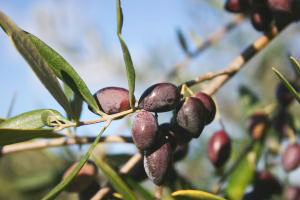
Olive oil is pressed from the fresh-picked fruit of the olive tree. Photo by Iliana | SXC.
Updated June 2018 |
Product Reviews / Main Nibbles / Oils, Vinegars & Salad DressingsOlive Oil & Olives GlossaryPage 5: Terms With H To K
This is Page 5 of the Olive Oil & Olives Glossary. If you think we should consider terms or definitions than those we have provided, use the Contact Us links on this page. Also read our article, Flavors and Aromas of Olive Oil. Visit our collection of 60+ food glossaries to learn more about other food products. You can click on the letter of the alphabet in the bar below to get to a term a b c d e f g h i j k l m n o p q r s t u v w x y z This glossary is protected by copyright and cannot be reproduced in whole or part. HAND-PICKEDOlives that are picked by hand instead of harvested with a shaker or a row type harvester. Hand picking is considered to produce a better olive oil than fruit that is mechanically harvested. Mechanical harvesting can bruise the fruit, increasing acidity, but others argue that mechanically harvested fruit can also get to the press quicker, which lowers acidity. Detractors say that this might be true in a scenario of mass-produced oil, but any artisan-produced oil will harvested in much smaller amounts by hand gotten to the press within hours, the best of both worlds. Olives harvested with a hand-held pneumatic rake are usually considered “hand picked.” HARVESTINGHarvesting of the fruit is done in the autumn. Harvesting usually continues for about two months, or until the fruit becomes damaged by frost. The table olive harvest is done by hand-picking so as not to bruise the fruit; ladders are used to climb into the tree. HEALTH CLAIMSThe FDA allows olive oil manufacturers to place a health claim on bottles linking olive oil to reduced risk of coronary heart disease. Olive oil controls LDL (“bad”) cholesterol levels while raising HDL (“good” cholesterol) levels. Continuing research indicates there may be other benefits as well, from the redistribution of body fat to painkilling properties, but these have not yet received FDA sanction. HOJIBLANCA OLIVEOne of the major olive varieties of southern Spain, grown in the provinces of Córdoba, Granada, Malaga and Sevilla. Hojiblanca produces a yellow oil with a green and violet tinge. Its flavors vary between intense and fruity, and smooth and sweet. The oil is known for nuances of apple and green grass, which can give it a hint of bitterness, and almond finish. It is enjoyed for its smooth taste and lightness on the palate. Its stability is considered average.
|
© Copyright 2005-2026 Lifestyle Direct, Inc. All rights reserved. All images are copyrighted to their respective owners.
 INFUSED OLIVE OIL
INFUSED OLIVE OIL  for most of the world.
for most of the world. of the total Greek olive-growing area. Although difficult to cultivate, it has a high yield and produces olive oil of exceptional quality. The oil is very fruity, with an aroma of leaves and grass and a flavor with notes of green apple. It has some astringency, with hints of almond, fig and bark. Though very flavorful, it has low stability, i.e., has a short shelf life once the bottle is opened, so use it up quickly.
of the total Greek olive-growing area. Although difficult to cultivate, it has a high yield and produces olive oil of exceptional quality. The oil is very fruity, with an aroma of leaves and grass and a flavor with notes of green apple. It has some astringency, with hints of almond, fig and bark. Though very flavorful, it has low stability, i.e., has a short shelf life once the bottle is opened, so use it up quickly.